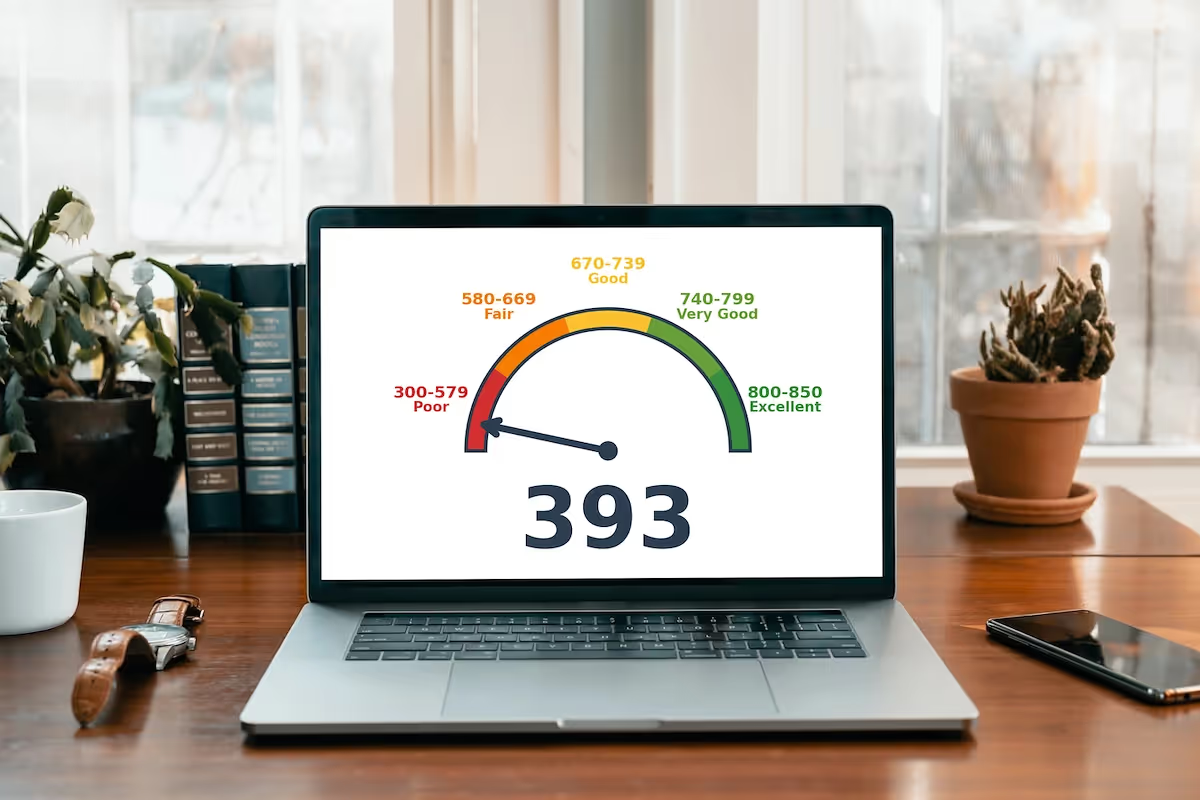
Kudos has partnered with CardRatings and Red Ventures for our coverage of credit card products. Kudos, CardRatings, and Red Ventures may receive a commission from card issuers. Kudos may receive commission from card issuers. Some of the card offers that appear on Kudos are from advertisers and may impact how and where card products appear on the site. Kudos tries to include as many card companies and offers as we are aware of, including offers from issuers that don't pay us, but we may not cover all card companies or all available card offers. You don't have to use our links, but we're grateful when you do!
393 Credit score: What You Need to Know in 2025
July 1, 2025


TL;DR
A 393 credit score provides a clear opportunity for growth, as it falls into the "Poor" FICO score category. Think of this as a foundational starting point from which you can begin building a much stronger financial future.
What Does a 393 Credit Score Mean?
A credit score of 393 places you squarely in the "poor" range of the FICO scoring model, which spans from 300 to 850. This score signals a history of significant financial difficulties to potential lenders. Consequently, it can create substantial hurdles in your financial life, making it extremely challenging to access credit or secure loans when you need them most.
With a score this low, you'll likely face rejections for most credit applications, including credit cards, auto loans, and mortgages. Any credit you might be offered will almost certainly come with very high interest rates and unfavorable terms. While this position presents serious financial challenges, it is not a permanent state; understanding where you stand is the first step toward building a stronger financial future.
Who Has a 393 Credit Score?
While age itself isn't a direct factor in credit score calculations, there is a strong correlation between age and creditworthiness. Generally, older individuals have higher scores because they've had more time to build a positive payment history and establish a diverse mix of credit accounts. Here are the average credit scores by generation, based on 2023 data from Experian:
- Generation Z (ages 18-26): 680 (Good)
- Millennials (ages 27-42): 690 (Good)
- Generation X (ages 43-58): 709 (Good)
- Baby Boomers (ages 59-77): 745 (Good)
- Silent Generation (ages 78+): 760 (Very Good)
Credit Cards With a 393 Credit Score
A credit score of 393 is considered very poor, placing you in the lowest range of credit scores. This can significantly hinder your ability to qualify for most traditional credit cards, as lenders view this score as a high risk. You'll likely face immediate rejections for unsecured cards from major banks and may need to explore options specifically designed for individuals with bad credit.
Kudos offers personalized recommendations by matching your financial goals, such as building credit responsibly, with suitable options from its database of nearly 3,000 cards. The platform provides unbiased suggestions and insights into how applying for a new card could impact your credit score, helping you make a more informed decision.
Auto Loans and a 393 Credit Score
A 393 credit score places you in the deep subprime category, which can make securing an auto loan challenging. While approval may still be possible, you will likely face significantly higher interest rates and less favorable terms.
According to an Experian report, average auto loan interest rates vary dramatically across different credit score brackets:
- Super-prime (781-850): 5.25% for new cars and 7.13% for used cars
- Prime (661-780): 6.87% for new cars and 9.36% for used cars
- Non-prime (601-660): 9.83% for new cars and 13.92% for used cars
- Subprime (501-600): 13.18% for new cars and 18.86% for used cars
- Deep subprime (300-500): 15.77% for new cars and 21.55% for used cars
Mortgages at a 393 Credit Score
A 393 credit score is considered extremely poor and falls well below the mortgage requirements for nearly all loan types. Even government-backed FHA loans, one of the most accessible options for buyers with poor credit, require a minimum score of 500. With a 393 score, eligibility for conventional, FHA, VA, or USDA loans is virtually nonexistent, making it highly unlikely you will qualify for a traditional mortgage.
In the rare event you found a specialty subprime lender willing to consider your application, the impact of your score would be severe. You would face significantly higher interest rates, a much larger down payment requirement, and a strict manual underwriting process. Lenders would also likely cap the amount you could borrow, severely limiting your home purchasing options and making any loan extremely costly over its lifetime.
What's in a Credit Score?
Your credit score is a complex calculation, but it primarily boils down to a handful of key factors from your financial history. Here are the most common components that credit bureaus evaluate:
- Your payment history is the most significant factor, tracking whether you pay your bills on time.
- Credit utilization measures how much of your available credit you are currently using.
- The length of your credit history considers the average age of all your accounts.
- Your credit mix refers to the different types of credit you have, such as credit cards, mortgages, and auto loans.
- Applying for or opening several new credit accounts in a short period can represent a greater risk.
How to Improve Your 393 Credit Score
Improving your credit score is entirely possible, and with consistent positive behavior, you can see meaningful changes within three to six months. While a 393 score requires significant work, focusing on a few key areas can start you on the right path.
- Monitor your credit reports. You can get free reports from AnnualCreditReport.com to check for errors or fraudulent activity that could be damaging your score. Correcting inaccuracies is a critical first step toward rebuilding your credit profile.
- Make on-time payments. Your payment history is the single most important factor in your credit score, so setting up automatic payments can prevent late fees and further damage. Establishing a consistent record of paying bills on time is fundamental to raising a very low score.
- Apply for a secured credit card. A secured card requires a cash deposit as collateral, making it easier to get approved for with poor credit. Responsible use is reported to the credit bureaus, helping you build a positive payment history from the ground up.
- Become an authorized user. Ask a trusted family member or friend with a strong credit history to add you to their account as an authorized user. Their good habits, like on-time payments and low credit utilization, can be reflected on your report and help improve your score.
The Kudos browser extension can help you manage your cards and monitor your score as you work toward your financial goals.
Unlock your extra benefits when you become a Kudos member

Turn your online shopping into even more rewards

Join over 400,000 members simplifying their finances

Editorial Disclosure: Opinions expressed here are those of Kudos alone, not those of any bank, credit card issuer, hotel, airline, or other entity. This content has not been reviewed, approved or otherwise endorsed by any of the entities included within the post.



































.webp)


.webp)

.webp)



